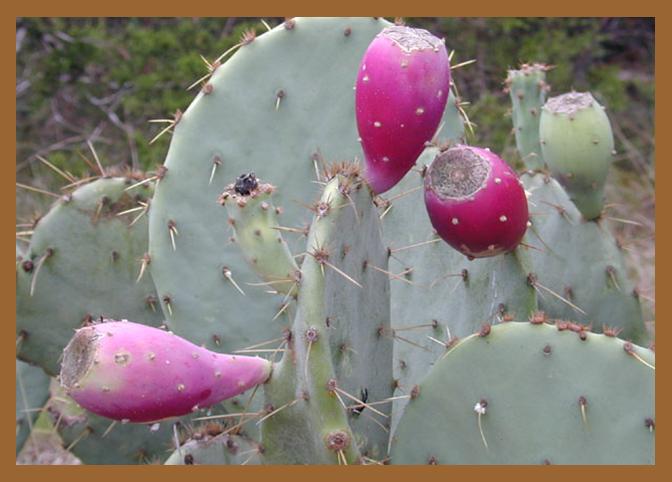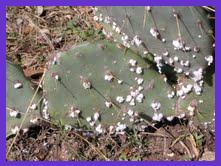Guide to SA Natural Areas & Greenway Trails
J: Prickly Pear Cactus

Prickly Pear Cactus from LBJ Wildflower Center
NPIN 11879 by Joseph A. Marcus
Alamo Area Master Naturalist Jessica Leslie is the author of this piece.
There are over 200 species of prickly pear cactus in the genus Opuntia. They are native only to the western hemisphere, but they have been introduced to other parts of the world.
FLAT, ROUNDED PADS - SPINES & GLOCHIDS
Opuntia species typically grow with flat, rounded pads or platycades with two types of spines, the harder, fixed spines and the smaller, hair-like spines, termed glochids, that easily detach from the cactus pad when in contact with another surface. The cactus produces a fruit or tuna that can be red, wine-red, green or yellow/orange depending upon the species.
NOPALITOS & TUNAS, TOO
Have you ever eaten a Prickly Pear cactus? If so, hopefully you removed the spines first! Both the pad and the fruit are used as a food source. The spines are removed from the pads by “sanding” them in a grit medium or by burning off the spines. The young stems or pads are often used as a vegetable or in a salad. In Mexican cuisine, the sliced or chopped pads can be found in egg dishes and in tacos. The fruit or tunas are used to make jellies, candies and beverages.
THE STORY OF COCHINEAL
Another important use of the cactus is the production of cochineal dye. The dye is actually made from an insect that feeds upon the Prickly Pear cactus. Have you ever noticed small, white, cottony mounds on a cactus pad? They are Dactylopius coccus, a scale insect that feeds off the moisture and nutrients in the cactus sap. If you smash the insect between your fingers, it turns an intense maroon red. The insect produces carminic acid that helps to deter the bug’s predators. The acid is removed from the body and eggs of the insect to make the deep red dye.
Just how valuable was cochineal? Early Mixtec Indians used cochineal to dye their clothing to show social status. They actually farmed the cactus, working to develop different colors of red dyes. When the Spaniards arrived in Mexico, they became enamored of the deep red dye. Clothing was dyed with cochineal and shipped back to Europe. They could not ship enough of the textiles to keep up with the demand, so they began shipping the actual cochineal to Europe. Cochineal became second only to gold in value. After 250 years of Spanish domination of the dye, other countries became involved, and soon cochineal could be found all over the world.
In fact, whenever a natural red dye is desired, cochineal is still the popular choice today. Although artificial colors have replaced the use of natural ones, you can still find cochineal in several products today. Have you ever spread “bug juice” on your lips? Chances are, if you have used red lipstick, you have put cochineal dye on your lips. The two main uses of the dye are for red food coloring and for cosmetics, such as rouges and lipsticks. Anytime you notice these ingredients—carmine, natural red 4, CI 75470 or E120 natural coloring—the source is cochineal dye. It is used to color many fruit juices, such as Ruby Red Grapefruit juice, some brands of strawberry yogurt, tropical punch drinks, and water-color paints. Look for these ingredients next time you purchase some of these items.
LBJ Wildflower Center NPIN 13519 & 11885 by Joseph A. Marcus
Cochineal on Prickly Pear photographed by Wendy Leonard, January 2012.


